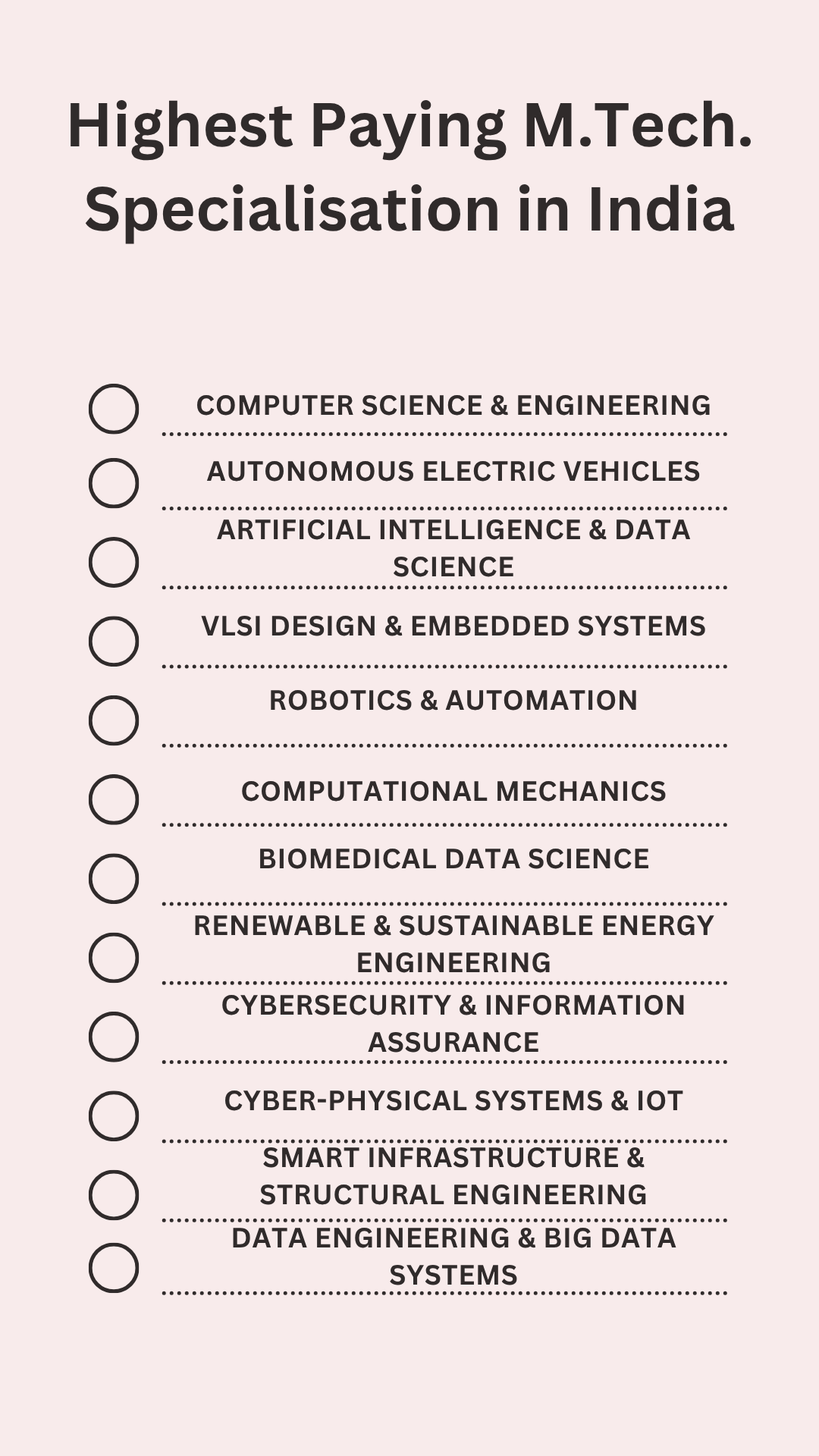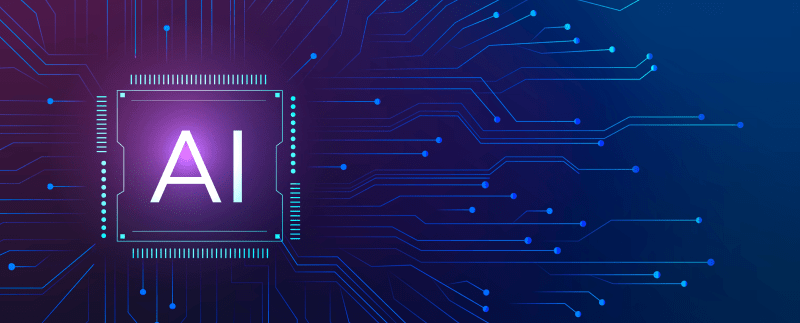Top High Paying M.Tech. Courses in India to Advance Your Career

The world’s growth story has always been powered by engineers. From building dams and steel plants to creating global IT platforms and now leading innovations in digital infrastructure, space tech, EVs and semiconductors.
But there is something changing now.
The economy is moving from doing to designing and from servicing to inventing. What started with service delivery is now about invention, ownership and transformation.
And what does that mean for you?
It means that the undergraduate degree in engineering may give you an opportunity to work, but to get a better job profile, more lucrative salary and lead the new technological advancement projects, you need to be a master of something, not a jack of all trades.
This is why now B.Tech. graduates are moving towards M.Tech. courses
If you are also one of those people who are thinking about doing M.Tech. But have some doubts in your mind, like is it really a good step to take? If yes, then which specialisations are highly rewarding? Then you’re asking the right question.
This blog addresses such queries and helps you make a decision about doing M.Tech., as well as helps you choose the right specialisation that fits your career aspirations.
M.Tech. After B.Tech. – Is This the Right Decision?
Choosing between an early job and a specialised degree is a real dilemma. Both ways have their own outcomes, but which one suits your goals?
If you dedicate your two years to the master’s degree, is it going to pay you in future? The answer is absolutely yes.
5 Drivers That Make M.Tech. Courses High-Paying
These five points explain why some M.Tech. courses pay more and why companies look for these graduates.
- Skill Scarcity
-
- Chips, controls, power systems, applied AI, etc, there are fewer experts than needed in every domain.
- Capital Intensity
-
- Projects involving electric vehicles, grids, hospitals and manufacturing lines carry high costs and errors can cost millions and billions. That’s why a specialised skill is paid well.
- Policy-Backed Demand
-
- Fields like semiconductors, clean energy and secure public infrastructure are backed by government policies.
- Research-to-Product Pathways
-
- Tech. programmes offer access to real research facilities, labs and industry projects, which help you build a powerful portfolio.
- Global Roles and Mobility
-
- M. Tech. graduates who have published papers and have a strong project portfolio get priority in R&D roles and Ph.D. programmes.
Top High Paying M.Tech. Courses in India

- Computer Science & Engineering
Where it’s used
- Digital public infrastructure (UPI, Aadhaar, etc.)
- Fintech platforms and core banking
- Scalable SaaS products and cloud-native services
Core competence
- Distributed systems
- Operating systems and storage internals
- Secure coding, performance tuning
- Fault tolerance and system reliability
Entry roles & growth ladder
- Platform Engineer / SRE
- System Software Developer
- Principal Architect / Staff Engineer
- Autonomous Electric Vehicles
Where it’s used
- EV Original Equipment Manufacturers
- ADAS integration companies
- Battery management system development
- Gigafactories and EV R&D labs
Core competence
- Vehicle control systems
- Perception and localisation
- Battery thermal and charge management
- Safety-critical software and certification
Entry roles & growth ladder
- BMS Engineer / Control Systems Engineer
- Functional Safety Developer
- Autonomy Systems Lead
- Artificial Intelligence & Data Science
Where it’s used
- Public health (triage, diagnostics)
- Financial analytics and credit risk
- Supply chain optimisation
- Language translation systems
Core competence
- Machine learning & statistical reasoning
- Deep learning for vision and NLP
- MLOps and production pipelines
- Causal inference and experimentation
Entry roles & growth ladder
- ML Engineer / AI Engineer
- Data Science Tech Lead
- AI Research Engineer
- VLSI Design & Embedded Systems
Where it’s used
- Semiconductor design companies
- Embedded firmware for consumer electronics
- Automotive and industrial electronics
- Fabless SoC development
Core competence
- RTL design and verification
- Physical design and timing closure
- Firmware on RTOS platforms
- Power/performance trade-off engineering
Entry roles & growth ladder
- RTL Design Engineer
- Verification / Physical Design Engineer
- SoC Lead Architect
- Robotics & Automation
Where it’s used
- Industrial automation and smart factories
- Warehouse robotics and logistics
- Hospitals and medical robotics
- Defence and agriculture systems
Core competence
- Robot kinematics and control
- Computer vision and localisation
- Motion planning and safety protocols
- Human–robot interaction (HRI)
Entry roles & growth ladder
- Robotics Engineer / Integrator
- Motion Planning Developer
- Autonomy and HRI Architect
- Computational Mechanics
Where it’s used
- Aerospace, automotive and civil engineering
- Energy and structural simulations
- Medical device design
Core competence
- Finite element modelling
- Computational fluid dynamics
- Verification and validation
- Structural optimisation and material simulation
Entry roles & growth ladder
- CAE Analyst
- Design Verification Lead
- R&D Specialist
- Biomedical Data Science
Where it’s used
- AI-powered diagnostics and hospital systems
- Omics research and bioinformatics
- Public health platforms
Core competence
- Biostatistics and data cleaning
- ML for imaging, genomics and patient data
- Clinical validation and privacy protocols
Entry roles & growth ladder
- Health Data Scientist
- Clinical AI Engineer
- Bioinformatics Lead
- Renewable & Sustainable Energy Engineering
Where it’s used
- Solar and wind power plants
- Battery Energy Storage Systems
- Microgrids and hybrid energy systems
- Green hydrogen projects
Core competence
- Power systems and smart grids
- Renewable resource modelling
- Converter control and system integration
- Techno-economic feasibility and lifecycle analysis
Entry roles & growth ladder
- Renewable Systems Engineer
- Grid Integration Specialist
- Energy Operations Lead
- Cybersecurity & Information Assurance
Where it’s used
- Banks and digital finance
- Utilities and OT networks (power, water, telecom)
- Defence, transportation and healthcare IT
Core competence
- Cryptography and secure protocols
- Network and app security
- OT (Operational Tech) and ICS protection
- Threat intelligence and incident response
Entry roles & growth ladder
- Security Analyst / AppSec Engineer
- OT Security Specialist
Cyber Defence Architect
- Cyber-Physical Systems & IoT
Where it’s used
- Industrial IoT and automation
- Agri-tech and smart farming
- Smart buildings and logistics
- Fleet and asset tracking
Core competence
- Sensor interfacing and embedded design
- Edge computing and fail-safe mechanisms
- Time-Sensitive Networking
- Resilience and Over-the-Air updates
Entry roles & growth ladder
- Embedded Systems / IoT Engineer
- CPS Integration Lead
- Reliability or Solution Architect
- Smart Infrastructure & Structural Engineering
Where it’s used
- Metro projects and high-rises
- Seismic zones and long-span bridges
- Ports, tunnels and smart cities
Core competence
- Seismic and performance-based design
- BIM (Building Information Modelling)
- Digital twin modelling
- Lifecycle cost optimisation
Entry roles & growth ladder
- Structural Design Engineer
- SHM Analyst
- BIM/Digital Twin Lead
- Data Engineering & Big Data Systems
Where it’s used
- Banking and e-commerce platforms
- Mobility and smart transport
- Healthcare, governance and CPS back-ends
Core competence
- Distributed data systems
- Real-time and batch processing
- Data modelling, governance, lineage tracking
Entry roles & growth ladder
- Data Engineer / Platform Engineer
- Data Infrastructure Architect
- MLOps and Analytics Ops Lead
Planning for M.Tech. Course After B.Tech.? Start Your Journey at Mahindra University
Mahindra University embodies the ‘Rise of the New Engineer’, a bold, future-ready vision realised through a landmark collaboration between Tech Mahindra, École Centrale Paris and Jawaharlal Nehru Technological University Hyderabad.
Pursuing your M.Tech. course at Mahindra University gives you access to world-class infrastructure, a cutting-edge research facility and mentorship opportunities, which prepare you to be an impactful engineer.
M.Tech. Specialisations Offered at Mahindra University
- Computer Aided Structural Engineering
- Transportation Engineering
- Artificial Intelligence & Data Science
- Autonomous Electric Vehicles
- VLSI Design & Embedded Systems
- Advanced Wireless Communication
- Systems Engineering
- Robotics
- Computational Mechanics
- Bio Medical Data Sciences
The purpose of these M.Tech. programmes is to create post-graduate engineers who can respond effectively to global engineering challenges and can incorporate new technologies that will define the future
Synopsis
The high paying M.Tech. courses in India are built around one core principle: offering knowledge and skill depth that solves real problems.
Across domains, from chip design to energy systems, from cybersecurity to smart infrastructure, what separates high-value roles isn’t just domain knowledge, but the ability to translate theory into working systems under constraints of scale, safety and complexity.
If you’re choosing M.Tech. after B.Tech., don’t just pick what’s popular; pick a domain that’s not just in demand, but also aligns with your career aspirations.
Mahindra University offers a variety of M.Tech. courses, choose your specialisation and apply now!
FAQs
- Which M.Tech. specialisation pays the most right now?
Computer Science, AI & Data Science, Cybersecurity and VLSI top the list. Freshers with the right skills and relevant projects in their portfolio can earn even more than 25 lakh rupees per year. - Is M.Tech. better than taking a job right after B.Tech.?
It depends. If you want depth, R&D, or global roles, then M.Tech. is worth it. If you’re looking at entry-level roles, then a job after B.Tech. is the correct option. - Can M.Tech. help me go abroad?
Yes, especially with published work, standard contributions and projects under reputed faculty.


















































































































































































































![Arm_Yourself_with_Deep_Business_Knowledge_&_Insights_with_PhD_Program_in_Business_Administration_at_Mahindra_University[1] Arm_Yourself_with_Deep_Business_Knowledge_&_Insights_with_PhD_Program_in_Business_Administration_at_Mahindra_University[1]](https://i0.wp.com/www.mahindrauniversity.edu.in/wp-content/uploads/2023/04/Arm_Yourself_with_Deep_Business_Knowledge__Insights_with_PhD_Program_in_Business_Administration_at_Mahindra_University1.jpg?resize=1140%2C460&ssl=1)
![Emerge_as_a_Forward_thinking_Mechanical_Engineer_with_B_1140x460[1] Emerge_as_a_Forward_thinking_Mechanical_Engineer_with_B_1140x460[1]](https://i0.wp.com/www.mahindrauniversity.edu.in/wp-content/uploads/2023/04/Emerge_as_a_Forward_thinking_Mechanical_Engineer_with_B_1140x4601.jpg?resize=1140%2C460&ssl=1)
![B.Tech_in_Computer_Science_Engineering_(BTech_CSE)_Your_Gateway_to_Become_a_Computer_Genius_1140x460[1] B.Tech_in_Computer_Science_Engineering_(BTech_CSE)_Your_Gateway_to_Become_a_Computer_Genius_1140x460[1]](https://i0.wp.com/www.mahindrauniversity.edu.in/wp-content/uploads/2023/04/B.Tech_in_Computer_Science_Engineering_BTech_CSE_Your_Gateway_to_Become_a_Computer_Genius_1140x4601.jpg?resize=1140%2C460&ssl=1)
![Digital_Marketing_is_Booming_Globally_1140x460[1] Digital_Marketing_is_Booming_Globally_1140x460[1]](https://i0.wp.com/www.mahindrauniversity.edu.in/wp-content/uploads/2023/04/Digital_Marketing_is_Booming_Globally_1140x4601.jpg?resize=1140%2C460&ssl=1)
![MU_Electrical20Computer20Engineering_1140x460[1] MU_Electrical20Computer20Engineering_1140x460[1]](https://i0.wp.com/www.mahindrauniversity.edu.in/wp-content/uploads/2023/04/MU_Electrical20Computer20Engineering_1140x4601.jpg?resize=1140%2C460&ssl=1)
![BA_LLB_Hons_Course_at_Mahindra_University[1] BA_LLB_Hons_Course_at_Mahindra_University[1]](https://i0.wp.com/www.mahindrauniversity.edu.in/wp-content/uploads/2023/04/BA_LLB_Hons_Course_at_Mahindra_University1.webp?resize=1140%2C460&ssl=1)
![Management_&_Business_Administration_is_Tremendously_High[1] Management_&_Business_Administration_is_Tremendously_High[1]](https://i0.wp.com/www.mahindrauniversity.edu.in/wp-content/uploads/2023/04/Management__Business_Administration_is_Tremendously_High1.jpg?resize=1140%2C460&ssl=1)

![whyistraining&placementcellimportant[1] whyistraining&placementcellimportant[1]](https://i0.wp.com/www.mahindrauniversity.edu.in/wp-content/uploads/2023/04/why20is20training2020placement20cell20important1.png?resize=1140%2C460&ssl=1)
![TheDifferencesbetweenRights&Duties[1] TheDifferencesbetweenRights&Duties[1]](https://i0.wp.com/www.mahindrauniversity.edu.in/wp-content/uploads/2023/04/The20Differences20between20Rights2020Duties1.png?resize=1140%2C460&ssl=1)
![sleep_deprivation[1] sleep_deprivation[1]](https://i0.wp.com/www.mahindrauniversity.edu.in/wp-content/uploads/2023/04/sleep_deprivation1.jpg?resize=1140%2C460&ssl=1)
![SelfLoveBlogImage2[1] SelfLoveBlogImage2[1]](https://i0.wp.com/www.mahindrauniversity.edu.in/wp-content/uploads/2023/04/Self20Love20Blog20Image2021.png?resize=1140%2C460&ssl=1)


























































































































